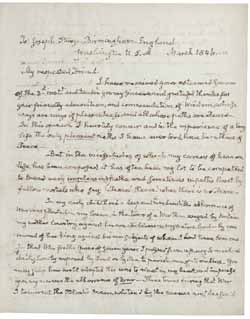Letter (draft) from John Quincy Adams to Joseph Sturge, March 1846
To order an image, navigate to the full
display and click "request this image"
on the blue toolbar.
-
Choose an alternate description of this item written for these projects:
- Bunker Hill
- Main description
[ This description is from the project: Coming of the American Revolution ]
This is a draft copy of a letter dated March 1846, from John Quincy Adams to Joseph Sturge, an English philanthropist and abolitionist who had visited the United States five years earlier. On page 3 of this letter, the 78-year-old Adams, recalls events that occurred near Boston in 1775, when he was eight years old. Adams was living in Braintree and recalls seeing Charlestown burn in the distance on 17 June 1775, during the Battle of Bunker Hill.
"unintermitted danger"
John Quincy Adams writes of the palpable danger his mother and his family experienced during 1775. They were living in Braintree, in close proximity to Boston, and what they learned about the movements of the British troops to Lexington in April and what they witnessed from a distance during the Battle of Bunker Hill--the town of Charlestown burning--resulted in explicit fears for their safety. John Quincy Adams also conveys how devasting the death of Joseph Warren was to him and his mother.
Questions to Consider
1. How long after the events being described was this account written?
2. According to JQA, why was the Boston area such a dangerous place to be?
Further Exploration
3. How does JQA's account differ from the one written by his mother the day after the battle? Click here to read Abigail's account.
4. What might account for the differences in the two descriptions of Bunker Hill?
5. What does this letter tell us about the way JQA remembered the dramatic events of his childhood?
6. What does it tell us about his views of motherhood? How does the image of his mother compare with the image of Abigail that comes from her own account?
7. What are some of the things that we need to be aware of when looking at reminiscences such as this?

